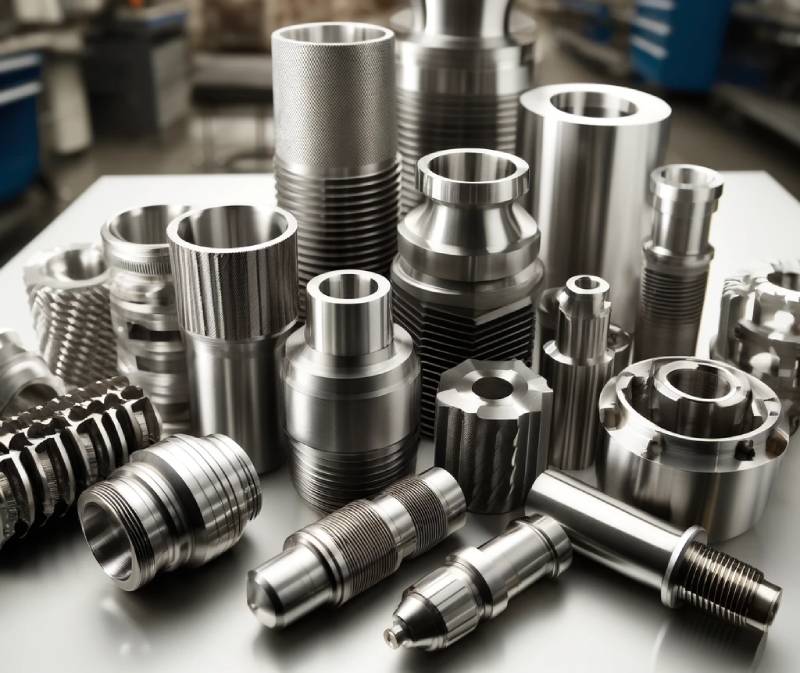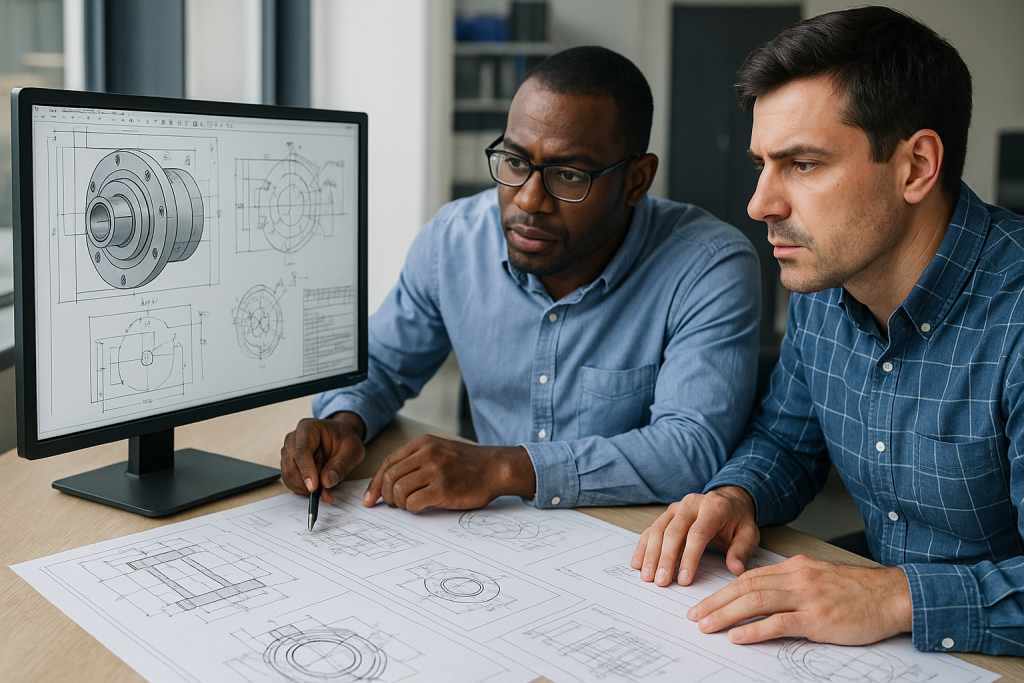
When it comes to CNC milled parts, surface finish is more than just an aesthetic choice—it’s a critical factor that influences durability, function, and performance. Whether you’re working on aerospace components, consumer electronics, or medical devices, the right surface finish can significantly improve the final product. In this article, we’ll walk you through the top five surface finishes for CNC-milled parts and help you decide which is best for your needs.
I. As-Milled Finish
As-Milled (also called as-machined) is the default surface straight off the CNC machine. It retains visible tooling marks and delivers a roughness average (Ra) typically between 1.6 µm and 3.2 µm, depending on tooling and material.
🔍 Key Data
| Parameter | Value Range |
|---|---|
| Roughness (Ra) | 1.6–3.2 µm |
| Cost | No additional cost |
| Appearance | Metallic, matte |
✅ Best for:
-
Functional prototypes
-
Internal mechanical components
-
Precision fits
This finish is ideal for rapid prototyping and when budget or turnaround time is tight. At Boona Prototypes, CNC machining services often start with this baseline finish to ensure tight tolerance and fast delivery.
II. Bead-Blasted Finish
Bead blasting uses pressurized glass beads or grit to produce a uniform, matte texture that hides tool marks and reduces glare. It’s a cost-effective way to upgrade appearance without breaking the bank.
🔍 Key Data
| Parameter | Typical Result |
|---|---|
| Surface Texture | Matte/Satin |
| Ra | ~2.0–3.0 µm |
| Aesthetic Rating | ★★★★☆ |
✅ Best for:
-
Consumer electronics
-
Decorative housings
-
Wear-resistant outer shells
Explore Boona’s finishing services here, where bead-blasting is offered for a variety of metals like aluminum and stainless steel.
III. Anodized Finish (Type II and Type III)
Anodizing enhances both the look and corrosion resistance of aluminum parts. Type II is mostly decorative, available in various colors; Type III (hardcoat) provides exceptional wear and scratch resistance.
🔍 Key Data
| Parameter | Type II | Type III (Hardcoat) |
|---|---|---|
| Thickness | 1.8–25 µm | 25–150 µm |
| Color Options | Many (black, red, etc) | Limited (gray/black) |
| Corrosion Resistance | Moderate | Excellent |
✅ Best for:
-
Aerospace and automotive parts
-
Consumer products
-
Harsh environmental use
Boona Prototypes offers anodizing options for aluminum alloys, which can be integrated into your CNC machining projects. Learn more on their aluminum CNC page.
IV. Polished / Mirror Finish
Polishing involves buffing the surface until it becomes reflective, sometimes achieving Ra values as low as 0.4 µm. This finish is best for components where friction needs to be minimized or aesthetics are paramount.
🔍 Key Data
| Parameter | Value |
|---|---|
| Surface Roughness | 0.4–1.6 µm |
| Reflectivity | High (mirror-like) |
| Labor Intensity | High |
✅ Best for:
-
Optical or medical components
-
Luxury hardware
-
Low-friction applications
At Boona Prototypes, polishing is often used after precision CNC milling for parts needing optical clarity or high-end presentation.
V. Brushed / Textured / Knurled Finish
Brushed finishes are created with abrasives to make directional lines that diffuse light, offering a sophisticated matte appearance. When grip is important, knurling adds raised patterns.
🔍 Key Data
| Finish Type | Typical Use | Texture |
|---|---|---|
| Brushed | Panels, enclosures | Linear grain |
| Knurled | Handles, grips | Crosshatch |
✅ Best for:
-
Industrial enclosures
-
Gripping tools
-
Consumer product design
Boona Prototypes specializes in providing surface options for tactile and functional enhancements. Their facility allows for fine knurling and directional brushing on various metal surfaces.
🔧 Summary Table of Finishes
| Finish Type | Ra (µm) | Appearance | Cost Impact | Best For |
|---|---|---|---|---|
| As-Milled | 1.6–3.2 | Matte, raw | Low | Prototypes, functional parts |
| Bead-Blasted | ~2.0–3.0 | Matte, uniform | Low-Med | Consumer enclosures |
| Anodized Type II | 1.8–25 | Colored, smooth | Medium | Consumer, corrosion resistance |
| Anodized Type III | 25–150 | Gray/Black | Medium-High | Aerospace, durability |
| Polished | 0.4–1.6 | Mirror/glossy | High | Optical, luxury, medical |
| Brushed/Knurled | Varies | Textured | Medium | Handles, casings, tools |
Choosing the right finish depends on:
| Criteria | Recommended Finish |
|---|---|
| Low budget | As-Milled, Bead-Blasted |
| Corrosion resistance | Anodized Type II or III |
| Luxury appearance | Polished, Brushed |
| Grip or tactile use | Knurled, Textured |
| Long-term durability | Hardcoat Anodizing or Powder Coating |
Surface finishing is not just the last step in the CNC machining process—it can define the success of your product. From affordability to functionality and aesthetics, there’s a finish for every need.
For end-to-end CNC machining and surface finishing, consider working with Boona Prototypes. Their full-service offering, precision equipment, and expert staff ensure your parts not only fit perfectly but look the part too.
FAQs
Q1: What is the most cost-effective surface finish for CNC machined parts?
The most affordable option is the As-Milled (or as-machined) finish. It requires no additional processing and is ideal for internal components, prototypes, or low-visibility parts. For slight aesthetic upgrades, bead blasting is also a low-cost choice.
Q2: Which finish provides the best corrosion resistance?
Anodized Type III (Hardcoat) finish offers superior corrosion and wear resistance, especially for aluminum parts. It’s commonly used in aerospace and marine environments. You can learn more about suitable materials for anodizing at Boona Prototypes’ aluminum machining page.
Q3: Can I polish stainless steel or titanium CNC parts?
Yes. Both stainless steel and titanium can be polished to a mirror finish, although the process is more labor-intensive than with softer metals. Polishing is ideal for medical instruments, optics, or decorative applications.
Q4: What’s the difference between bead blasting and brushing?
Bead blasting gives a uniform, matte texture by using pressurized abrasive particles, while brushing creates a directional grain using abrasives. Brushing adds a textured visual appeal, whereas bead blasting is better for removing tool marks and softening the surface.
Q5: Do surface finishes affect part tolerances?
Yes. Some finishes like anodizing and polishing can slightly alter part dimensions, especially in high-precision applications. It’s important to apply surface treatments after final machining, and communicate tolerance requirements clearly with your manufacturer.
Q6: Which finish should I choose for a consumer-facing metal part?
Consider brushed, polished, or anodized Type II finishes. They offer great aesthetic value and can be customized with color or texture. Boona Prototypes offers surface finishing specifically tailored to product appearance and durability needs.
Q7: Can CNC machined parts be anodized in color?
Yes. Type II anodizing allows for a range of color options including black, red, blue, and more. It enhances aesthetics while offering moderate corrosion resistance.
Q8: How long does it take to apply surface finishes?
Lead time varies by finish:
-
As-Milled: No extra time
-
Bead Blasted or Brushed: 1–2 days
-
Anodizing/Polishing: 3–5 days depending on complexity
Finishing time is usually included in Boona Prototypes’ manufacturing timeline, especially for large batch production.



